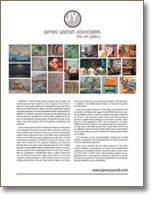 |
| |
 |
WHATS NEW
|
|
| march 2010, Paris-Museum DOrsay |
| |

March, 2010 – Me outside the Museum D’Orsay in Paris

Museum D’ Orsay, M 'O, March, 2010

Fantin Latour, "The Corner of the Table" (1872)
The serious color palette and biographical portrait remains so large in scope and achievement; it is, at the same time, romantic and important. I could barely fathom what it would be like to paint this way or to have it be my contemporary life setting to portray as reality.

link to view
Rodin, "The Age of Bronze"
This particular angle of the bronze was so beautiful to view in person, capturing the narrowness of the thin, upper torso stretching delicately into high, open space of the former train station/museum.

Renoir, "Young Boy with Cat" (1868)
The colors of early Renoir are all so cool, with grey-porcelain skin tones; for those who know me, what connected me most was the cat and the two subjects enveloped in pure, mutual affection.

Renoir
A late Renoir, a painting that illustrates the Impressionistic-style of light through the foliage, which seems to be its purpose rather than portraying a portrait. Despite the salmon pink blush of her cheeks, critics of the day thought the flesh appeared corpse-like, with the various colors of fashion being unnatural. Their reaction was still in objection to the new painting style of the times.

Claude Monet, "Camille Monet on Her Deathbed" (1879)
An interesting contrast lingers in Monet’s deathbed portrait, where the figure, only visible as an image, is the subject as she clings to life.

Edouard Manet, "Reading" (1865)
More than the painting as a whole, the painterly handling of the left side’s sheers against the windows and how the plant foliage is cut into the surface of the painting captured my attention. In person, it was very exciting to see the paint appear so fresh, as if the artist had just executed it.

Mary Cassat
Mary Cassat introduced America to Impressionist painting. The subject’s hands and arms appear so pale, it is fascinating to imagine how they were painted with such precision while capturing their softness.

link to view
An interesting composition; the yellow so effective.

link to view
Pierre Bonnard, "Twilight" (1892)
The patterns and the play of apple and chartreuse greens is so bohemian in feel when applied to the subject of croquet.

link to view
Pierre Bonnard, "In a Boat"
A very large painting, with planes of confusing perspective relaying the feeling that the viewer is looking at the scene from inside the boat. You can see the main figure is holding a black dog while a white dog sits behind it.

Klimt
Here, we see Klimt illustrate the subject of roses with the trademark pointillism style that never becomes tedious under his perfectionist hand.

Gustave Caillebotte "Self-Portrait" (1892)
With my personal interest in self-portraits, I am always drawn to seeing what an artist might reveal of himself, in spite of himself with his painting. The Impressionistic styling here masks for me the potential physiological complication.

link to view
Elie Delawnay "Egidio Sotta" (1887)
In this painting, I appreciate the artist’s offering of the subject with full disclosure, surrendering every detail. The humanity emboldened in the portrait is mesmerizing.

link to view
Edgar Degas, "The Bellelli Family" (1858)
The early family portrait portrays the mother in morning for her father and stoically responsible for her daughters care. The husband is working and separate in appearance, while all of the figures focus attention in different directions. The patterned blue wallpaper, mirror’s reflection and door frame are just part of what makes this circular composition so interesting.

link to view
Jacques Joseph James Tissot, "Portrait of the Marquis and Marchioness of Miramon and Their Children" (1865)
A formal family portrait with fineries on display; I appreciated the clarity of detail and how the mother’s energy channels into her child, who just glows upon receipt.

link to view
Alfred Stevens, "What is Called Vagrancy" (1854)
This painting reminded me of Russian genre paintings as it tells a story with fluid visual literacy. The sober winter colors and empathy of each character tell the story, so beautiful, yet so sad as the Brussels-born artist depicts the cruelty of laws condemning the homeless poor to prison.

link to view
Louis Welden Hawkins, "Les Orphelins" (1881)
Another sad painting of exquisite poetry; I am always awed by how such large subjects can be handled so simply and how an artist’s sensitivity can universally communicate stories and feelings with no words. Note the cat crossing over the stone wall.

Edouard Vuillard, "Jeanne Lanvin" (1935)
As mentioned, I decided to write the names and titles of all of the paintings that touched me during my day at the Museum D’ Orsay, and this portrait was so perfect, allowing the viewer to gain access to an interior office space so personal to the subject. I noted the use of color, such as the greys of the horizontal cabinet door and the lavender and red book bindings stacked above the formidable and elegant figure. As I copied the name, I was excited to see it was Jeanne Lanvin, the designer.
Pic 21
As excited as the day before, when I had spent my first jetlagged morning after landing in France visiting the Rue du Faubourg Saint-Honore address of Lanvin-Paris. A fun coincidence for me to have experienced Lanvin in two worlds, all the more memorable for me.

You can see my image in the reflection by the subject’s open book on her desk, holding my iPhone to snap the picture.
Museum days are always magical to remember and relive. |
| |
| |
| |
|
 |
|